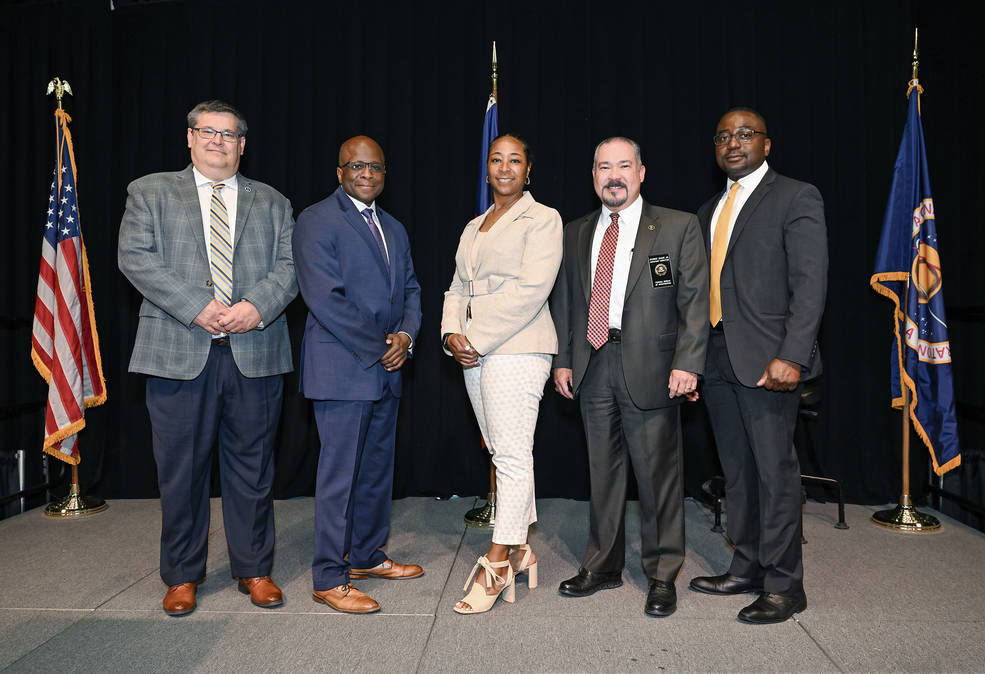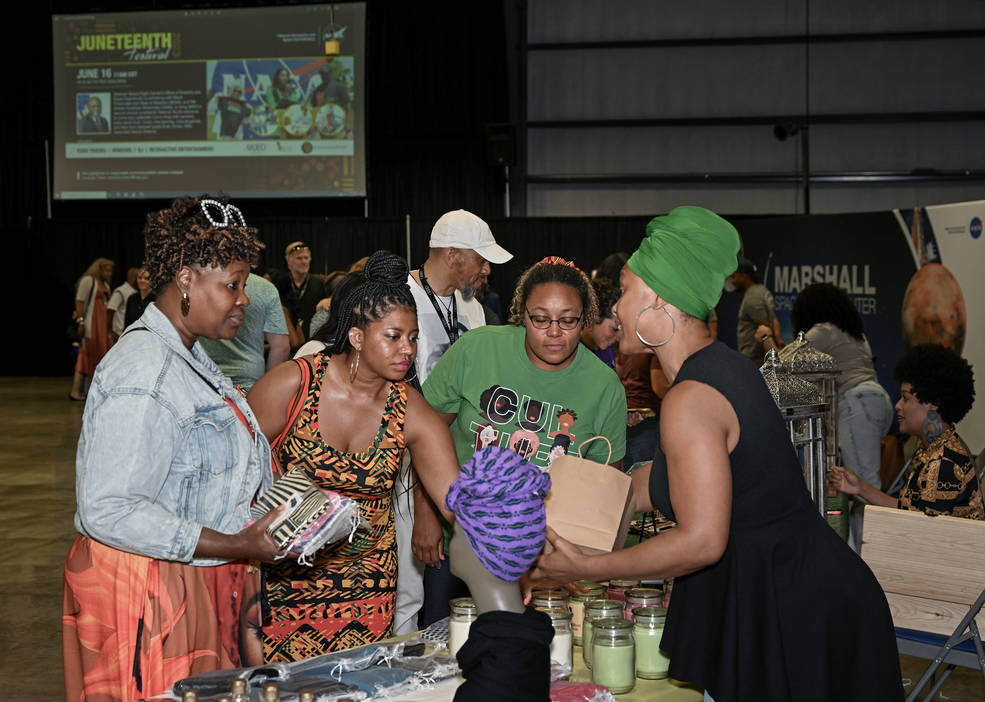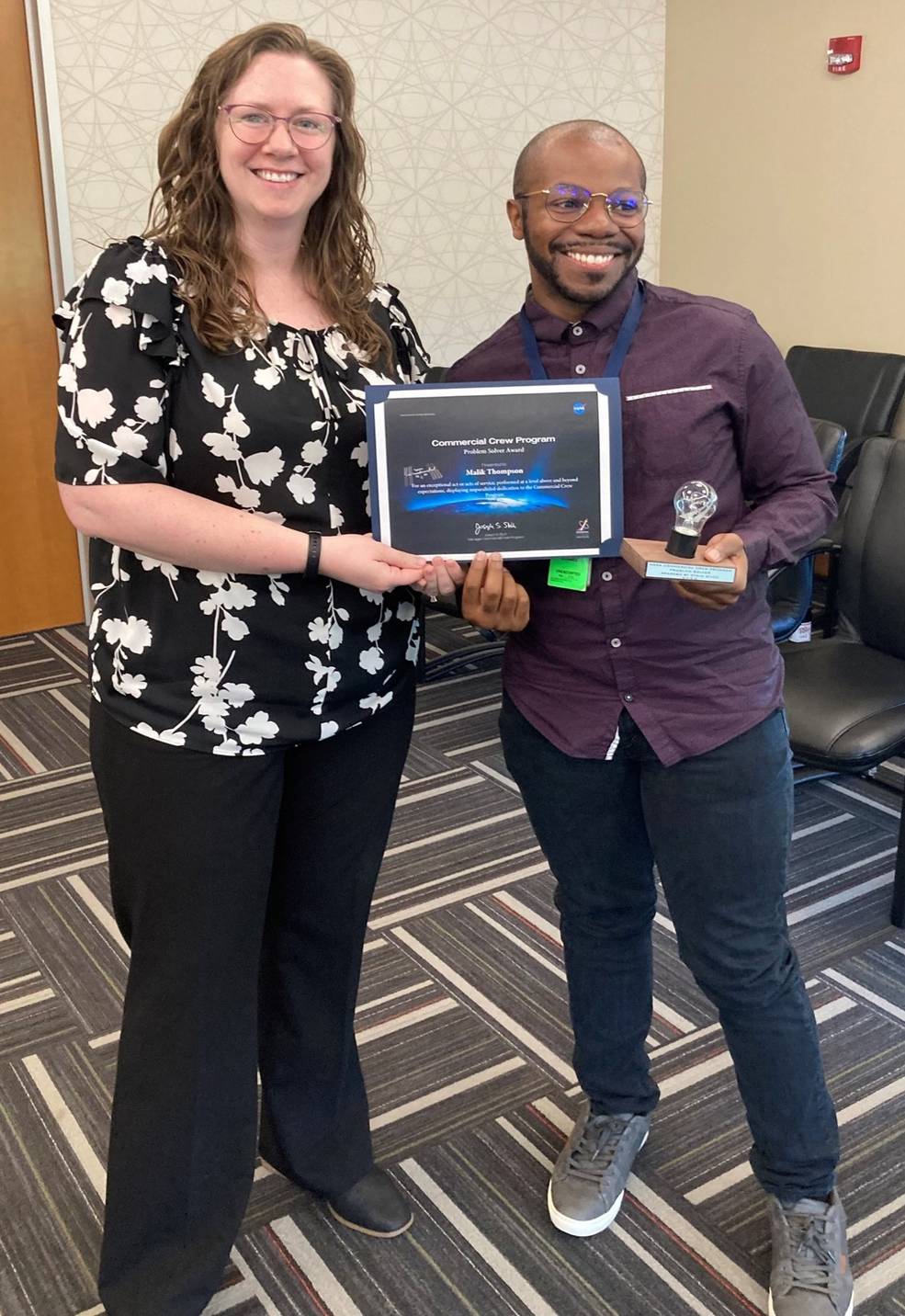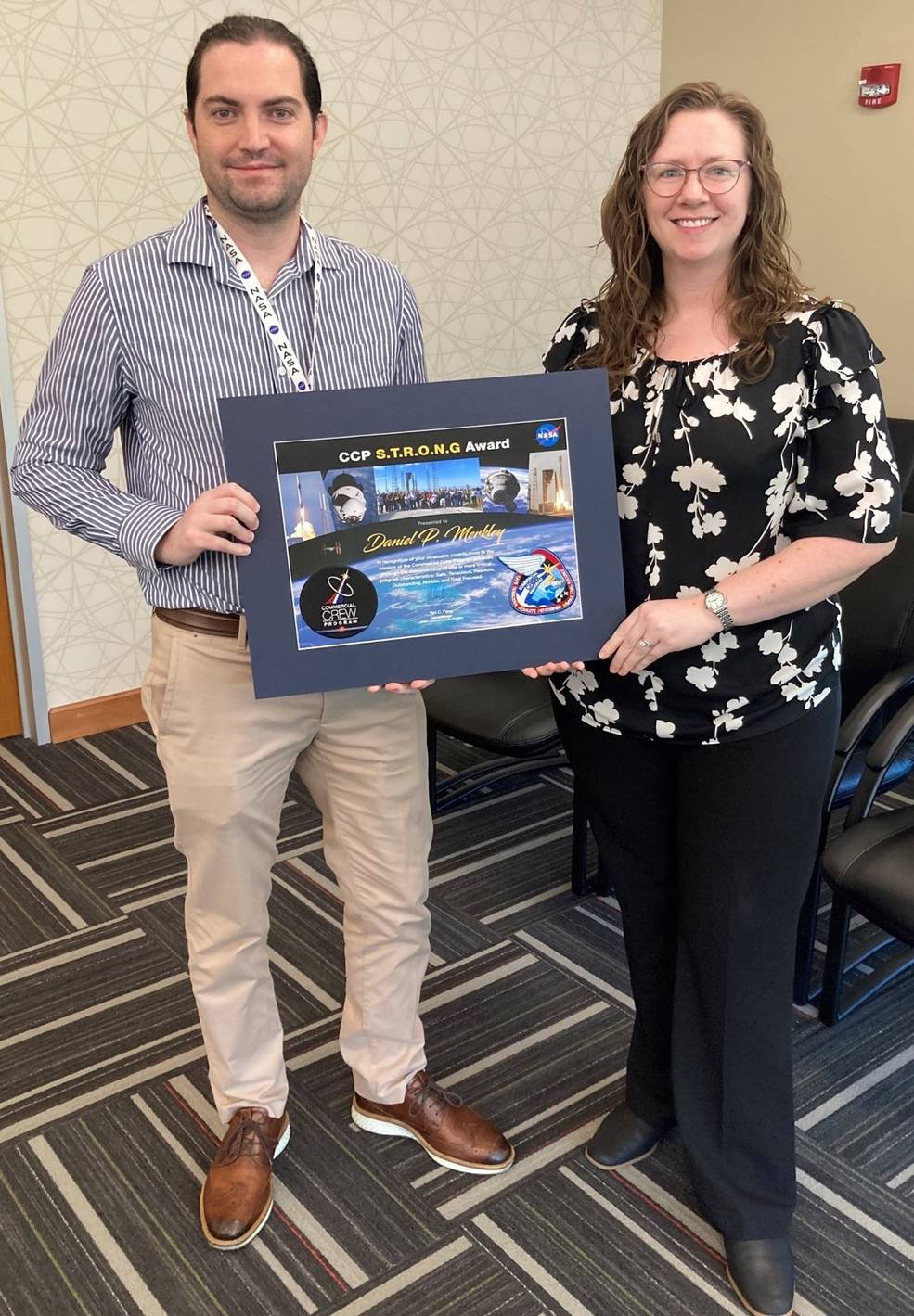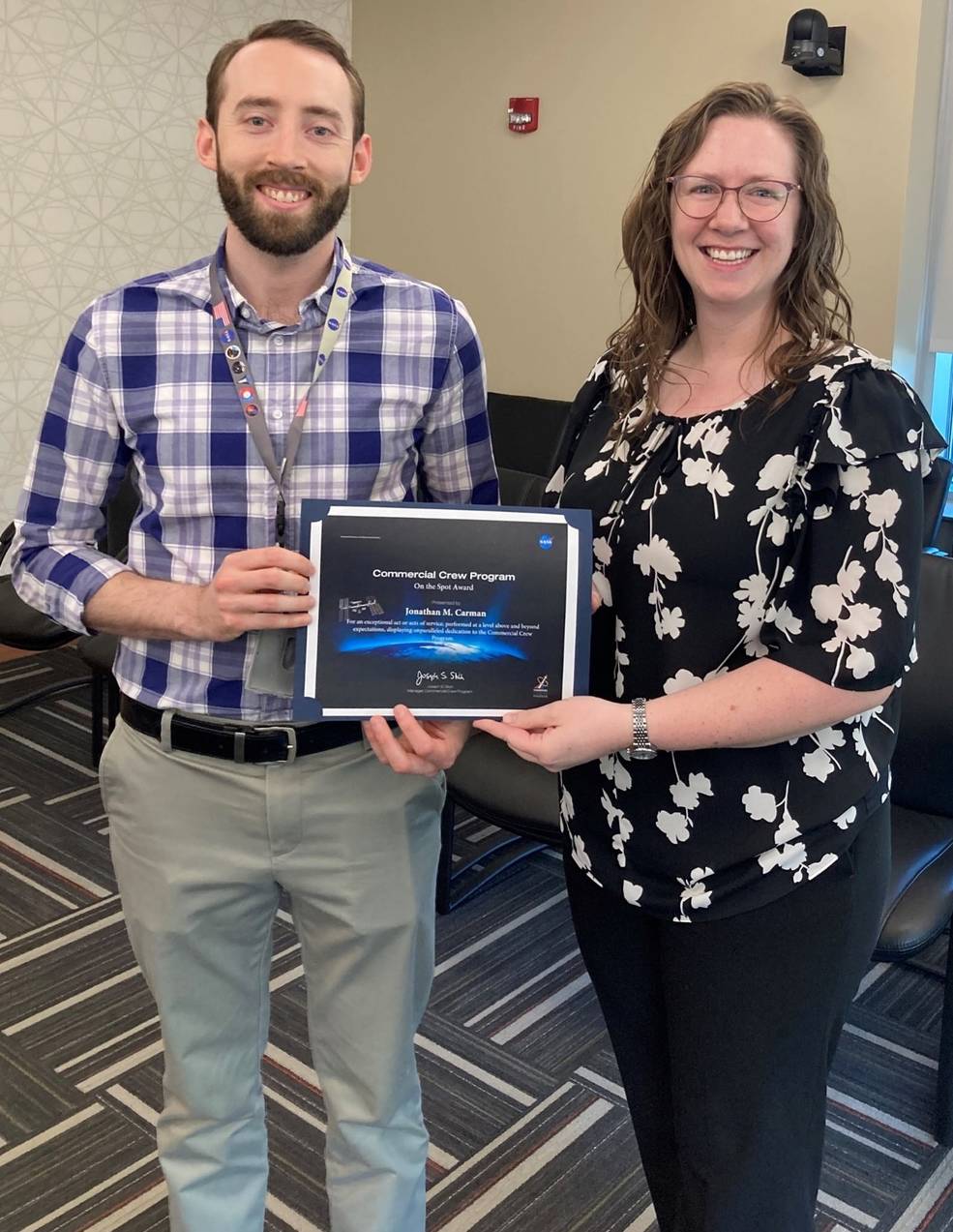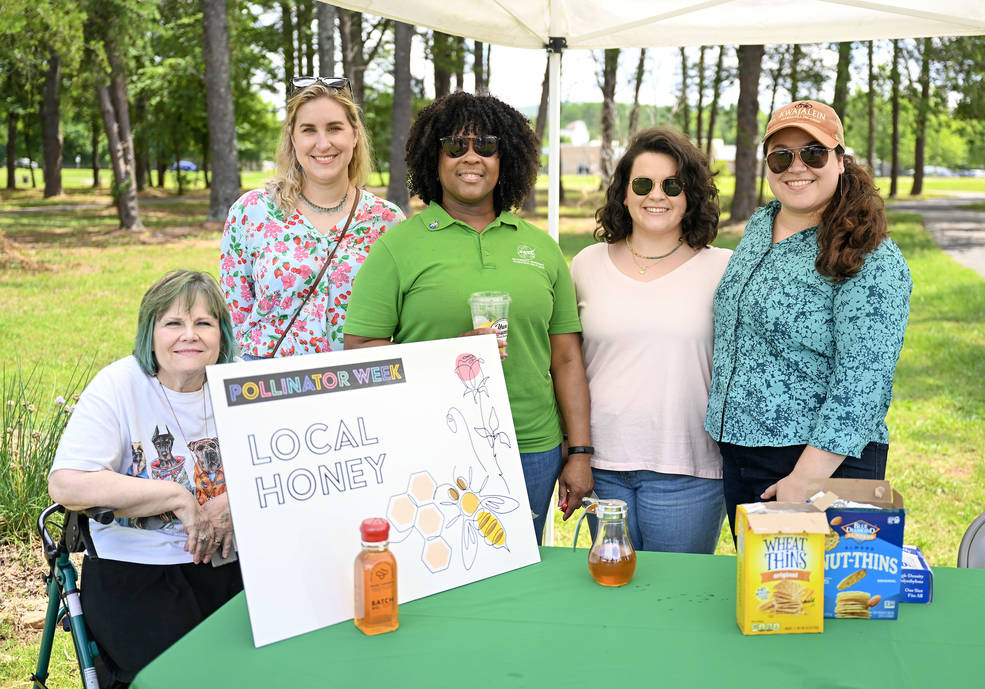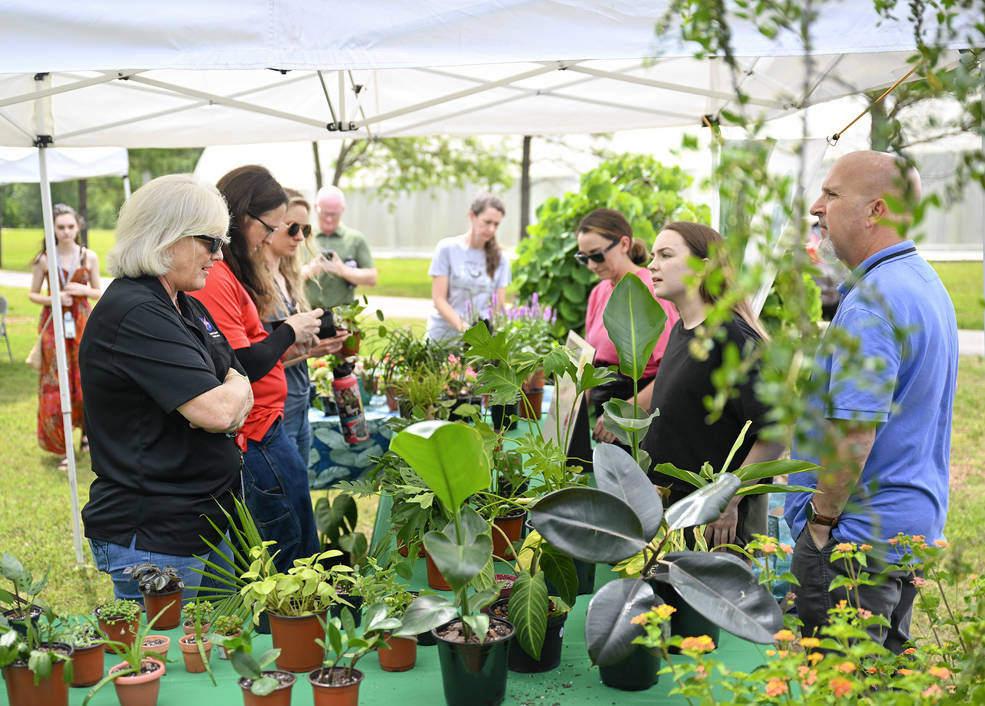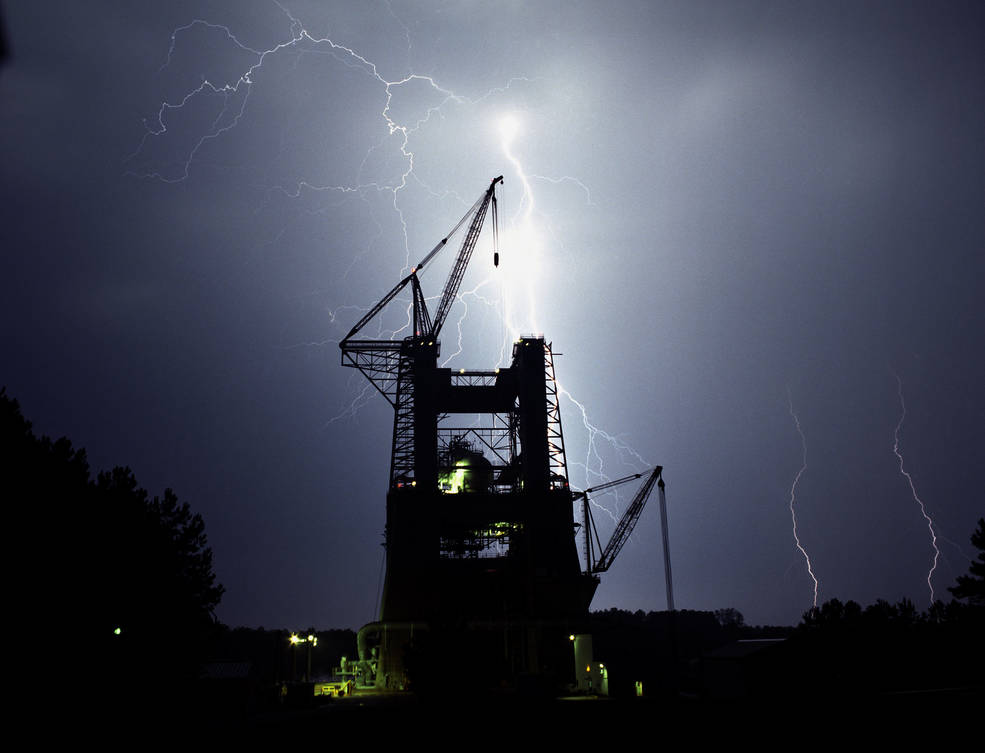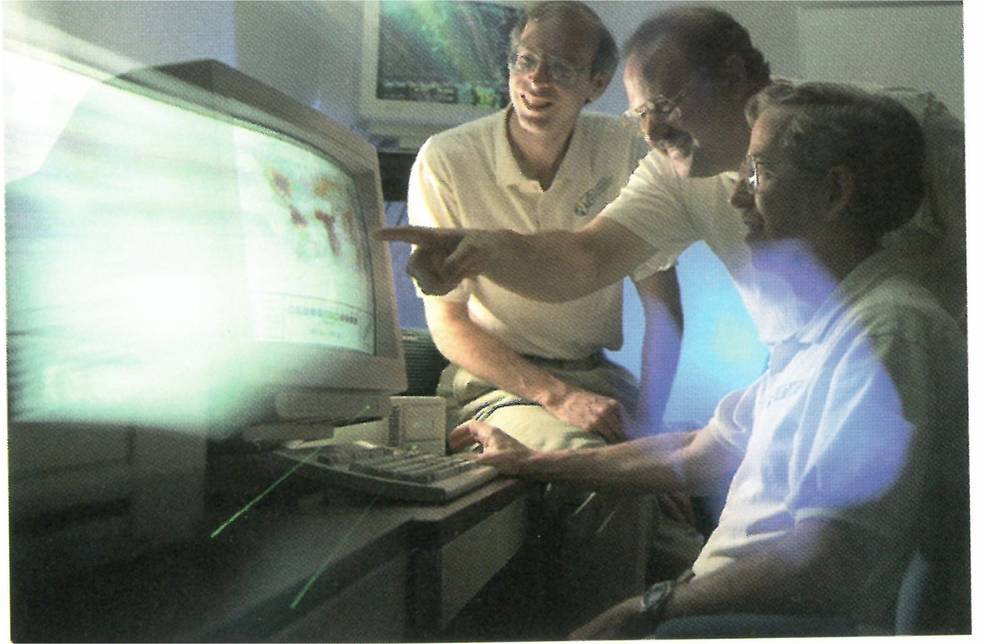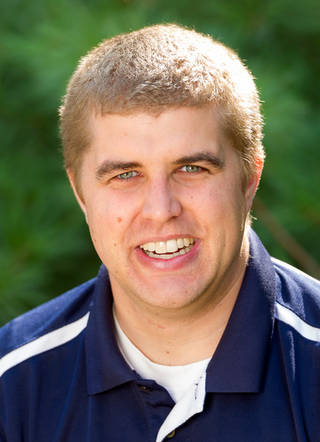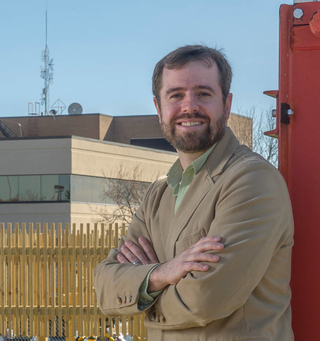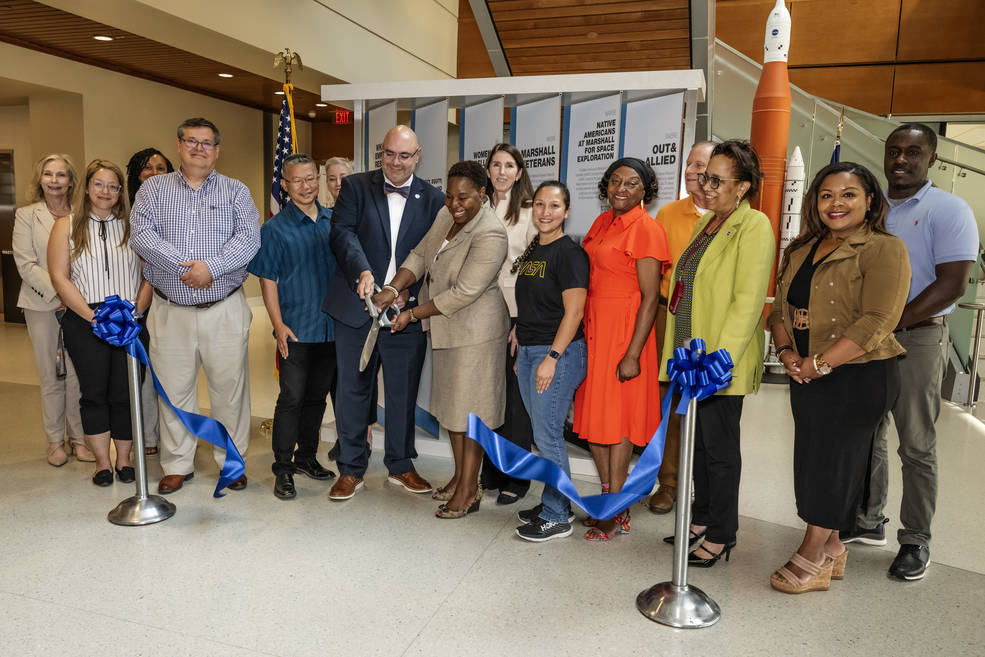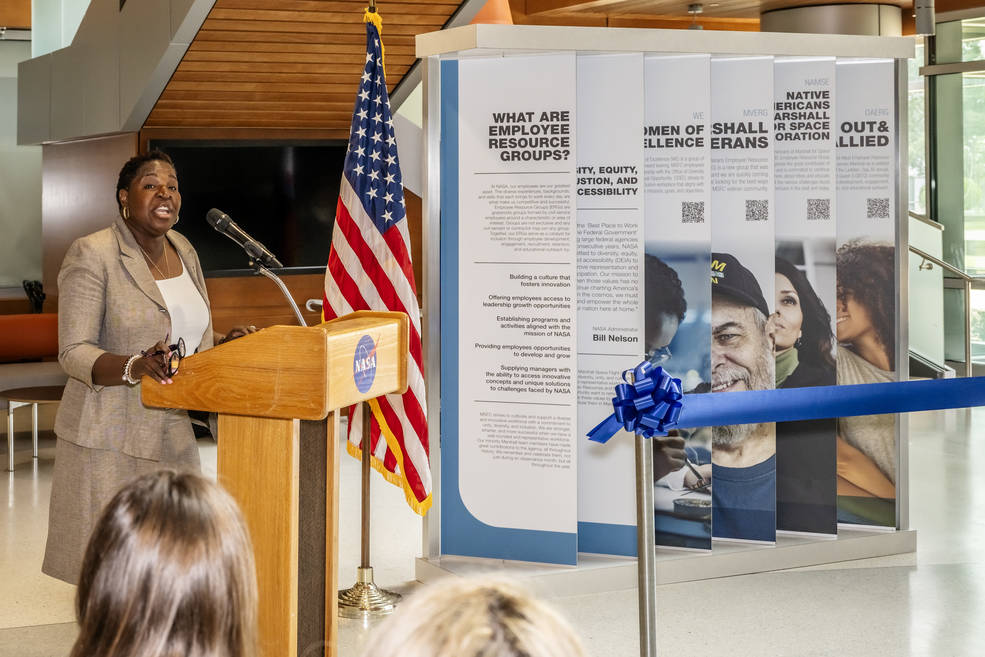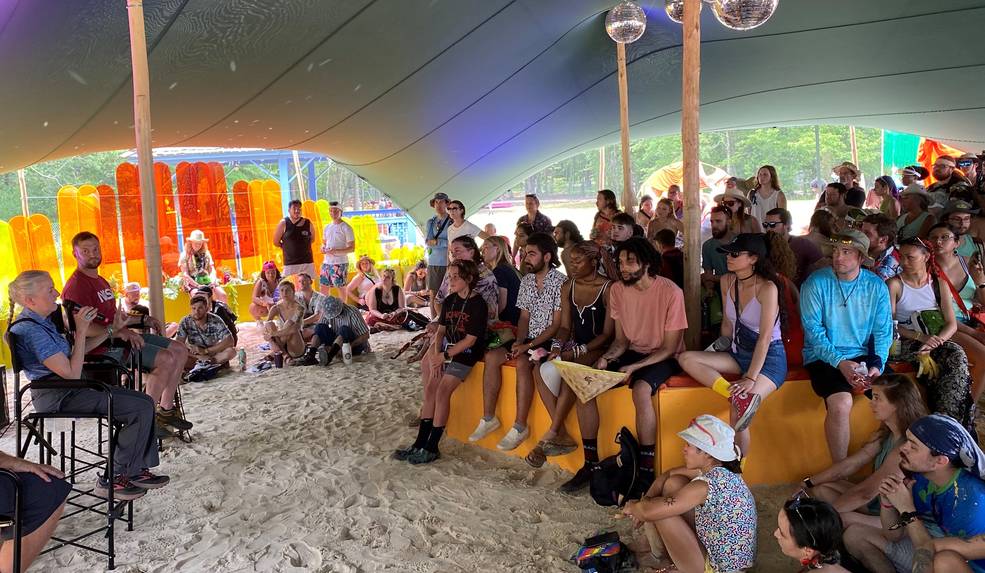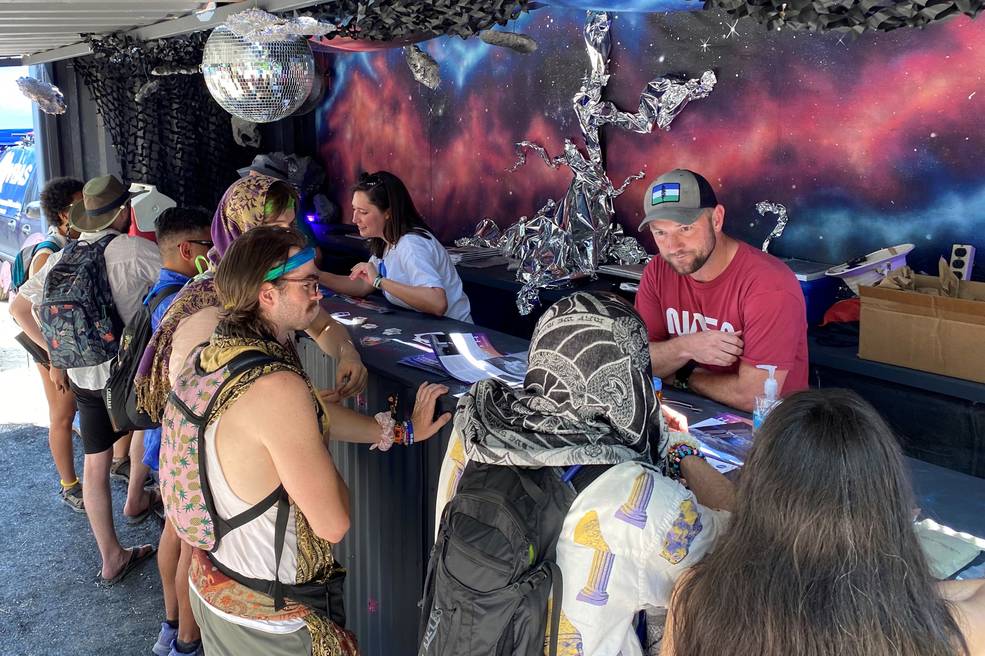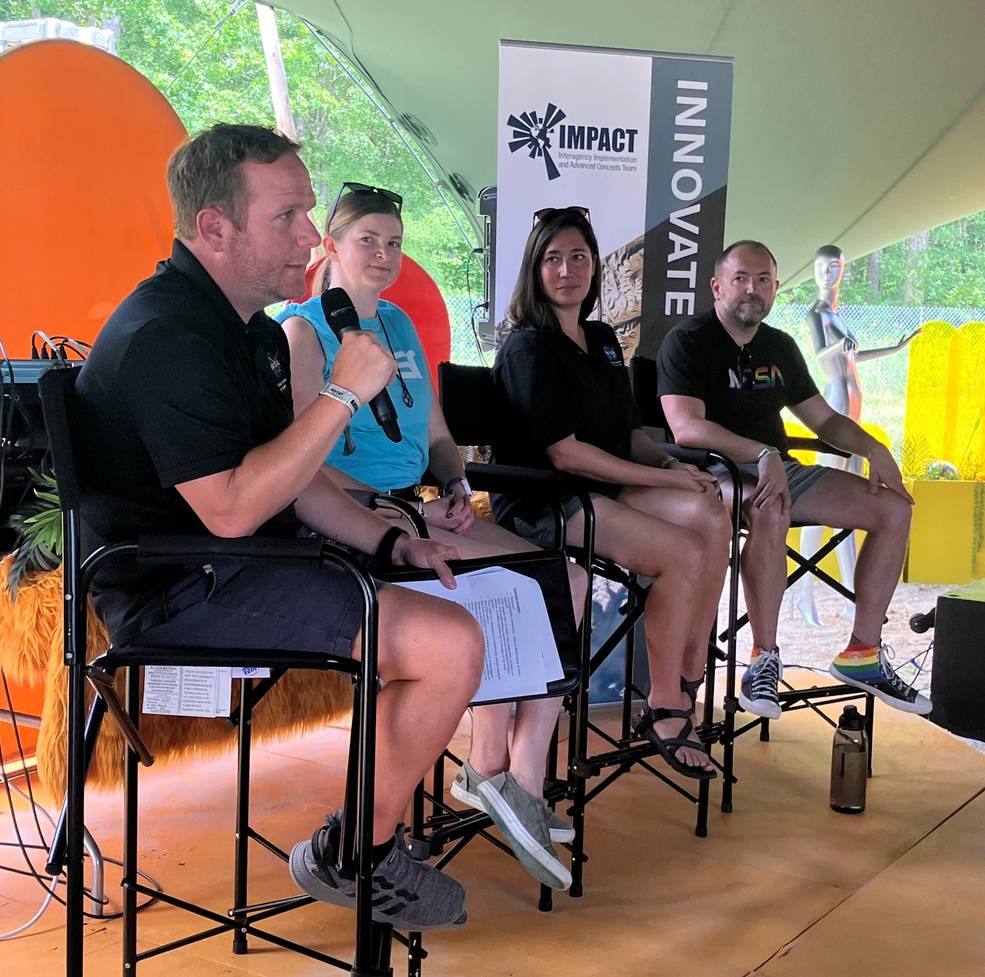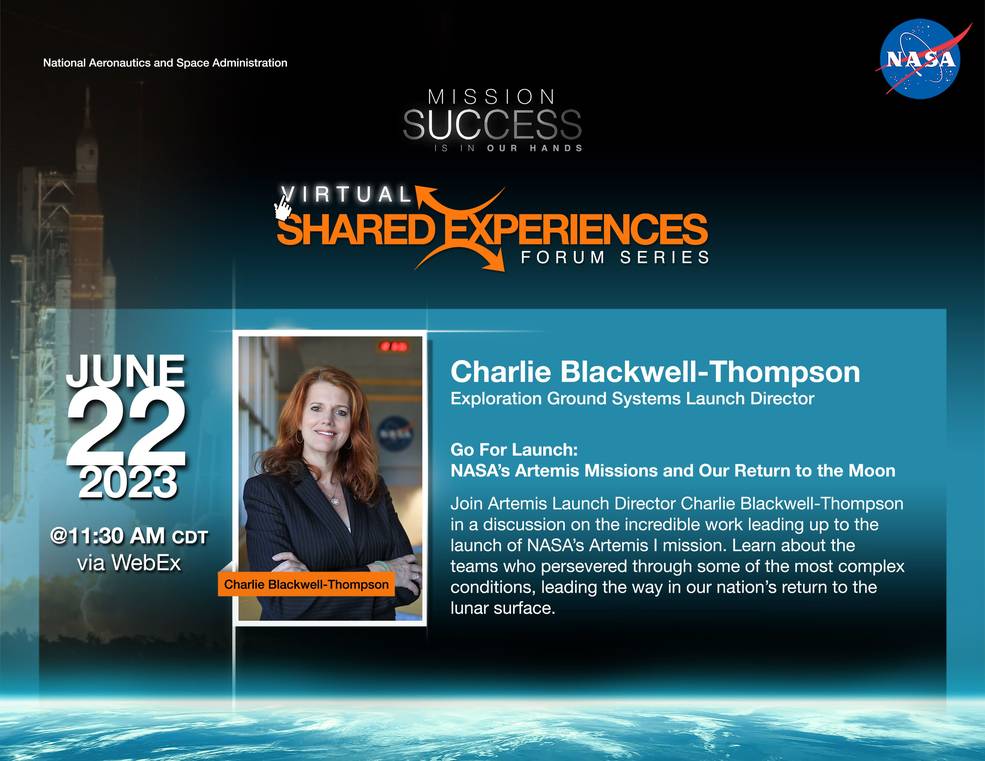The Marshall Star for June 21, 2023.
In This Week’s Star
- Marshall, FBI Teams Celebrate Juneteenth, Black Space Week
- Milky Way’s Central Black Hole Woke Up 200 Years Ago, NASA’s IXPE Finds
- Commercial Crew Program Awards Recognize 3 Marshall Team Members
- Marshall Volunteer Gardeners Host Pollinator Week Event
- Bright Legacy: Marshall Recognized as World Leader for Lightning Instrumentation, Research
- New Display Puts Spotlight on Marshall’s Employee Resource Groups
- Marshall Science Missions, Projects Featured at Bonnaroo Music & Arts Festival
- Stennis completes 11th RS-25 Engine Certification Test
- Charlie Blackwell-Thompson Speaker for Mission Success Event on June 22
Marshall, FBI Teams Celebrate Juneteenth, Black Space Week
The second annual Juneteenth festival was held June 16 in Activities Building 4316. From left are Larry Leopard, associate director-technical at NASA’s Marshall Space Flight Center; guest speaker Brian Turner, associate deputy director of the FBI; FBI special assistant Shafonda Jenkins; FBI Assistant Director Johnnie Sharp Jr.; and FBI Chief of Staff Lyonel Myrthil. Juneteenth is the oldest nationally celebrated event marking the end of slavery in the United States. Marshall also celebrated Black Space Week on June 21 during a virtual event, highlighting the center’s engineers and their contributions to NASA’s space exploration mission. Black Space Week aims to amplify the Black experience in space and science-related fields and celebrate those who directly contribute to scientific progress. (NASA/Charles Beason)
Marshall team members enjoy browsing apparel, cosmetics, and other vendors and exhibitors during the Juneteenth celebration. Participants also took part in games, sampled foods, and enjoyed a dance performance by Lecoledance Company. Amanda Otieno, an equal employment specialist in Marshall’s Office of Diversity and Equal Opportunity, said the event successfully demonstrated “the shared American experience, much like Cinco de Mayo or St. Patrick’s Day.” The Juneteenth event was jointly organized by Marshall’s Office of Diversity and Equal Opportunity, Black Employees and Allies at Marshall employee resource group, and the FBI’s African American Millennials employee group. Learn more about NASA’s Diversity and Equal Opportunity mission. (NASA/Charles Beason)
Milky Way’s Central Black Hole Woke Up 200 Years Ago, NASA’s IXPE Finds
By Rick Smith
Sagittarius A*, the supermassive black hole at the center of the Milky Way galaxy, is far less luminous than other black holes at the centers of galaxies we can observe, which means our galaxy’s central black hole has not been actively gobbling up material around it. Yet new evidence from NASA’s Imaging X-ray Polarimetry Explorer suggests the ancient sleeping giant woke recently – about 200 years ago – to devour gas and other cosmic detritus within its reach.
Sagittarius A*, often abbreviated by researchers to Sgr A* (pronounced “Sagittarius A-star”), is more than 25,000 light years from Earth – our nearest supermassive black hole, with an estimated mass millions of times that of our Sun. When previous X-ray studies detected relatively recent X-ray emissions of giant clouds of gas in its vicinity, scientists called on IXPE for a closer look.
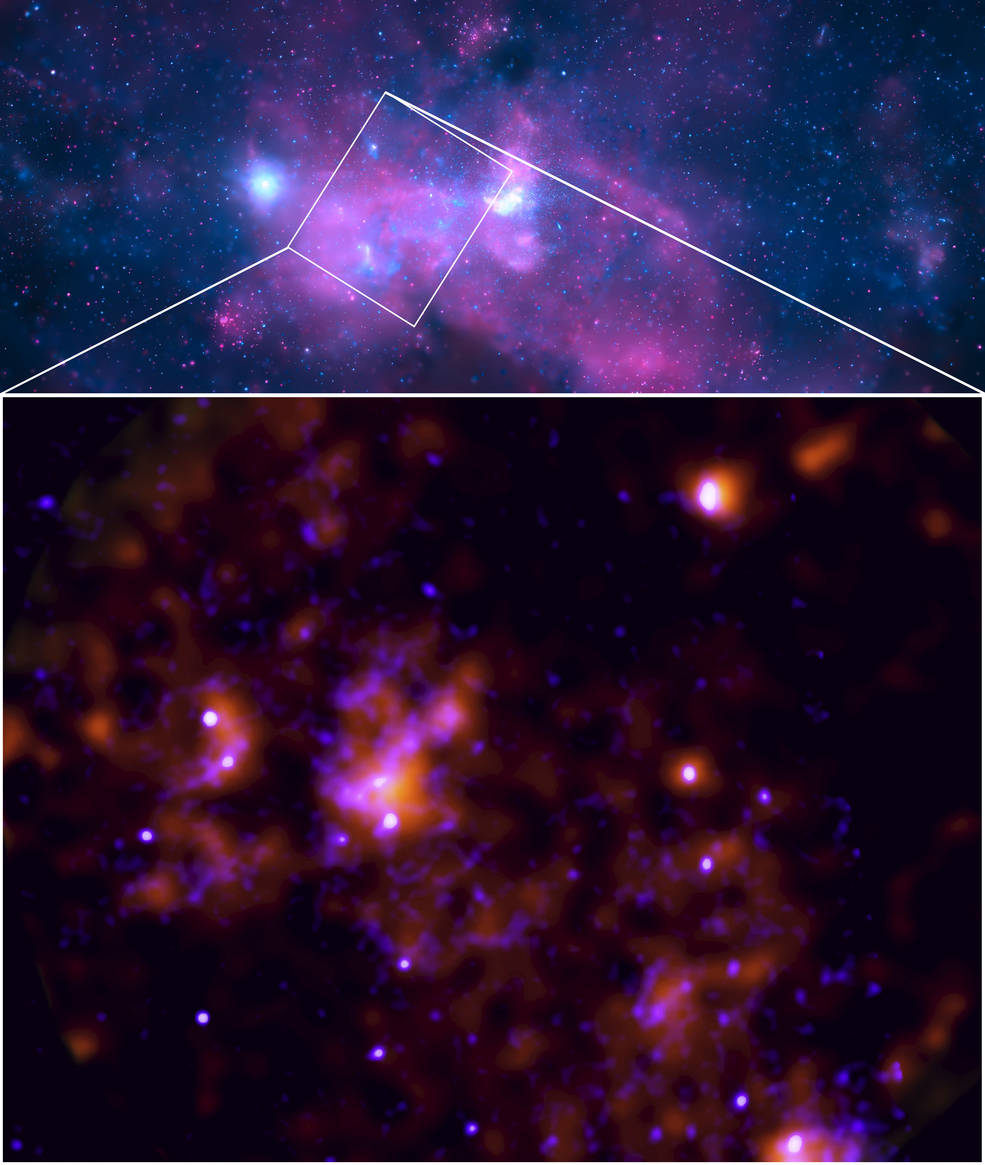
Given that most cosmic clouds, called “molecular clouds,” are cold and dark, the X-ray signatures of these clouds should have been faint. Instead, they shone brightly.
“One of the scenarios to explain why these giant molecular clouds are shining is that they are echoing a long-gone flash of X-ray light, indicating that our supermassive black hole was not that quiescent some centuries ago,” said Frédéric Marin, astronomer at the Astronomical Observatory of Strasbourg in France and lead author of the new study, published in the journal Nature.
IXPE, which measures polarization of X-ray light, or the average direction and intensity of the electric field of light waves, pointed at these molecular clouds for two periods of study in February and March 2022. When astronomers combined the resulting data with images from NASA’s Chandra X-ray Observatory and compared them to archival observations from the European Space Agency’s XMM-Newton mission, they could isolate the reflected X-ray signal and discover its point of origin.
“The polarization angle acts like a compass, pointing us toward the mysterious, long-gone source of illumination,” said Riccardo Ferrazzoli, astrophysicist at the Italian National Institute of Astrophysics in Rome. “And what lies in that direction? None other than Sgr A*.”
Analyzing the data, the team determined that the X-rays from the giant molecular clouds were reflected light from an intense, short-lived flare produced at or near Sgr A*, possibly caused by the black hole abruptly consuming nearby material.
The data also helped researchers estimate the luminosity and duration of the original flare – suggesting the event occurred some 200 Earth years ago, or roughly around the start of the 19th century.
Combined images of Sagittarius A* enabled researchers to develop a sonification – an adaptation of visual information into audible, even musical sounds. In this sonification, adapting data from IXPE and NASA’s Chandra X-ray Observatory, an arched line ripples across the image, starting at the lower righthand corner. As it passes over the orange-tinted IXPE data, sounds like digital winds are triggered, particularly where those orange areas are brightest. When the traveling line passes the blue-tinted Chandra data, the resulting notes resemble steel drums. Learn more about these cosmic harmonies.Credits: NASA/CXC/SAO/K.Arcand, SYSTEM Sounds—M. Russo, A. Santaguida
The team’s next goal is to repeat the observation and reduce the uncertainties of the measurement, said Steven Ehlert, IXPE project scientist at NASA’s Marshall Space Flight Center.
Follow-up data could improve estimations of when the flare occurred and how intense it may have been at its peak and will help determine the three-dimensional distribution of the giant molecular clouds surrounding the quiescent black hole.
Most importantly, he said, such studies help researchers gain a new understanding of the physical processes necessary to awaken Sgr A* again – even if just temporarily – from its uneasy slumber.
“IXPE is playing a key role in helping us better understand the timescale on which the black hole at the center of our galaxy is changing,” Ehlert said. “We know change can happen to active galaxies and supermassive black holes on a human timescale. We’re learning more about this one’s behavior over time, its history of outbursts, and we’re eager to observe it further to determine which changes are typical and which are unique.”
IXPE is a collaboration between NASA and the Italian Space Agency with partners and science collaborators in 12 countries. IXPE is led by Marshall. Ball Aerospace of Broomfield, Colorado, manages spacecraft operations together with the University of Colorado’s Laboratory for Atmospheric and Space Physics in Boulder.
Smith, a Manufacturing Technical Solutions employee, supports Marshall’s Office of Strategic Analysis & Communications.
Commercial Crew Program Awards Recognize 3 Marshall Team Members
By Celine Smith
Three NASA Marshall Space Flight Center engineers supporting the Commercial Crew Program’s (CCP) Launch Vehicle System Office (LVSO) were recently recognized for their roles in ensuring the safety and integrity of SpaceX missions as part of the agency program.
“Each of these team members demonstrated an unwavering commitment to the success of the mission and are well deserving of this recognition,” said Lisa McCollum, CCP LVSO deputy manager at Marshall. The award winners were recognized by CCP program managers during a stand-up meeting on June 1.
Malik Thompson received the Problem Solver Award. Thompson used his thermal protection system expertise to better understand the environments experienced by the Falcon 9 engine boot during flight. His team’s collaboration with SpaceX led to an improved testing method and valuable data on materials and environments.
The citation said Thompson “displayed strong leadership and collaboration skills by working with both the SpaceX team and Launch Vehicle System Office. He exemplified adaptability by integrating new information learned throughout the process and disseminating that information to CCP members.”
“Malik has a reputation for problem-solving, finding solutions for programs like SLS and IXPE,” said Lee Allen, branch chief. “This CCP Problem Solver Award is a perfect fit – he worked a complex testing approach to completion and is blazing a trail for other NASA and SpaceX engineers to collaborate in the future.”
Daniel P. Merkley was presented with the Unsung Hero Award and the STRONG (Safe, Tenacious, Resolute, Outstanding, Nimble, and Goal Focused) Award for continuously ensuring the safety of the Crew on CCP missions. His technical expertise and careful assessments enabled a thorough understanding and communication of flight rationale, both in preparation for the flight and on console during the pre-launch count. Merkley’s commitment to excellence and collaboration with SpaceX directly contributed to mission success for Crew-5 and Crew-6.
“[Merkley] consistently shows leadership by coordinating reviews among stakeholders, training new team members, presenting to CCP review boards, and other roles too many to mention,” said Miranda Holton, CCP launch vehicle engineering system manager. “His work ethic and can-do attitude is a definite asset to the team.”
Jonathan M. Carman and Jarel Lawrence, who work for NASA’s Kennedy Space Center, were presented with the On-the-Spot Award for proactively creating a backup plan for impending severe weather.
Their pre-emptive thinking allowed the LVSO on-console support team at the Huntsville Operations Support Center (HOSC) to safely execute the second Crew-6 launch attempt during a tornado warning. Even though the team had to relocate to their designated storm shelter, Carman and Lawrence’s plan preserved open communication lines. The launch still took place with no qualms because of their preparation. In the face of such adversity, the team still obtained thorough data to support the decision to launch.
“Jonathan’s attitude and willingness to work with the entire team has proven an invaluable help to the overall team,” Holton said of the Marshall team member.
Smith, a Media Fusion employee, supports Marshall’s Office of Strategic Analysis & Communications.
Marshall Volunteer Gardeners Host Pollinator Week Event
The Pollinator Club at NASA’s Marshall Space Flight Center hosted an event June 20 to show off the center’s pollinator garden and demonstrate the benefits of cultivating a healthy biosphere of flowering plants and other greenery to support local populations of bees, butterflies, and other pollinating insects. Club representatives included Marshall sustainability lead Malene McElroy, center front, and from left, Marshall team members Belinda Bishop, Joni Melson, Marla Smith, and Hannah McCarty. The event is part of Pollinator Week, the annual nationwide environmental activity held this year from June 19-25. (NASA/Charles Beason)
During the Pollinator Week event, nearly 100 Marshall team members explored the center’s pollinator garden, which is situated between Building 4315 and the Redstone Arsenal walking trail. The garden is a volunteer-maintained collection of more than 160 plants, mostly drought-tolerant perennials which will draw pollinating insects. The habitat, a registered Monarch Waystation, is certified with the North American Butterfly Association. There are no fees or annual dues required to join the Marshall Pollinator Club. If interested, email lyndsey.m.winslette@nasa.gov or learn more here. (NASA/Charles Beason)
Bright Legacy: Marshall Recognized as World Leader for Lightning Instrumentation, Research
By Liz Junod
NASA’s Marshall Space Flight Center is a world-leader in building cutting-edge instruments to study the science of lightning and improve safety. With June 18-24 recognized as National Lightning Safety Awareness Week, how did Marshall become a global leader in lightning?
In 1979, Dr. Jim Dodge, the Weather Focus Discipline program manager in the Earth Science Division at NASA Headquarters, held a meeting at the University of Tennessee Space Institute. Dodge brought in lightning experts from across the country to explore whether it would be feasible to make lightning measurements from space. Dr. William Vaughan of Marshall attended this meeting and was instrumental in establishing NASA’s expertise in lightning science and technology.
Shortly after this meeting, NASA selected Marshall to develop a space sensor that used optical lightning detection. This effort was led by Dr. Hugh Christian and supported by lightning scientists Dr. Richard Blakeslee and Dr. Steve Goodman.
In the early years, the team focused on determining the parameters needed to design and build a space instrument that could accurately detect and locate lightning over the Earth, with the ultimate goal being to place a lightning mapper in geostationary orbit. The critical technology breakthrough for measuring lightning from space occurred when the team discovered how to successfully detect lightning during daytime. Previous attempts to see lightning from space during the day were hindered by the bright sunlit cloud backgrounds that masked lightning.
“During those early years and beyond, we actively promoted the value and applications of lightning observations to the broader research and operational communities at every opportunity, which paid off once these data became available,” Blakeslee said.
While the initial team was small, today the team has grown into international acclaim and expertise, touching on every aspect of atmospheric electricity, lightning research, and applied sciences. The lightning team at Marshall is led by Dr. Timothy Lang, Dr. Mason Quick, Dr. Bill Koshak, Dr. Patrick Gatlin, and Dr. Christopher Schultz.
Why build instrumentation to study lightning?
Studying lightning comes down to two main objectives: safety and scientific understanding. Lightning causes between 30-40 deaths a year in the United States. Lightning fatalities are more common during the summer months as people spend more time outdoors. To better understand how lightning forms, research scientists needed to study how lightning generates within a storm.
One outcome of new lightning technology is defining rapid increases in lightning as storms strengthen, called lightning jumps. Lightning jumps occur as vertical motion in storms increases in size and magnitude.
“We do not measure vertical motion consistently with radars, so the lightning jump serves as a signal that the potential for hail, high winds, and tornado will increase in the next 15-30 minutes,” Schultz said.
When combined with other remote sensing tools like radar and numerical modeling, lightning jumps inform forecasters at the National Weather Service of rapid transitions in storm structure and severe potential.
What instrumentation has Marshall built or supported?
Scientist and engineers at Marshall, the University of Alabama in Huntsville, and their partners developed and built the first space-based lightning detectors with high detection capabilities here at Marshall. The detectors include the Optical Transient Detector, which was active from 1995 to 2000, and the Lightning Imaging Sensor (LIS) which was flown on the Tropical Rainfall Measuring Mission from 1997 to 2015. A second LIS was launched to the International Space Station in 2017 and remains active.
“These low-Earth orbit instruments truly demonstrated the effectiveness and value of using space-based lightning observation as a remote sensing tool and paved the way for the development of the geostationary lightning sensors,” Blakeslee said.
The Marshall team also contributed to the commercially built Geostationary Lightning Mapper (GLM) aboard the National Oceanic and Atmospheric Administration’s Geostationary Operational Environmental Satellite (GOES-R) series. GLM is based on the design heritage of the Pathfinder Marshall instruments. The lightning mapper design concepts are also being used by European and other space agencies for their operational geostationary mappers.
The lightning team at Marshall also refined the design of ground-based sensors to measure strong electric fields from overhead clouds and thunderstorms that can inform risks to launch vehicles and personnel involved in outdoor activities. The need for ground-based sensors was amplified when two NASA rockets were struck by lightning at NASA’s Kennedy Space Center launch pad.
The team then took the lead and developed the next generation of the electric field sensor network that now exists at Kennedy and Wallops Flight Facility to help detect high electric fields and lightning within the area before space launches.
What is the future for lightning at Marshall?
Today, Marshall continues to use ground, airborne, and space-based lightning sensors to advance lightning research and develop lightning safety products the public can use.
Dr. Patrick Gatlin, a research meteorologist with the lightning team at Marshall, was recently funded by NASA Headquarters to investigate a satellite measurement concept that uses a constellation of small satellites (SmallSats) with new lightning instruments being designed at Marshall and the Los Alamos National Laboratory to obtain three-dimensional maps of lightning on a global scale.
“These small satellites will help create a global picture from where lightning originates within the cloud and the path it takes to either strike the ground or remain within the cloud,’ ” Gatlin said. “This will allow us to better connect lightning to thunderstorm processes and its effect on the surrounding environment.”
To expand our knowledge of lightning detection toward this SmallSats concept, Marshall recently built 30 optical sensors known as the Fly’s Eye GLM Simulator (FEGS). Led by Dr. Mason Quick, FEGS flies above thunderclouds on the high-altitude ER-2 aircraft and is presently deployed for the Airborne Lightning Observatory for FEGS and Terrestrial gamma-ray flashes (ALOFT) field campaign this July.
Using GLM data, Schultz is currently developing applications that will proactively predict when lightning will strike.
“We all know the saying, when thunder roars, go indoors. Most people hear thunder or see lightning and then react,” Schultz said.
Working with Marshall’s Short-term Prediction Research and Transition Center (SPoRT), Schultz is using machine learning techniques to predict lightning 10-15 minutes before the next flash.
“So rather than being reactive to an event, we’re telling you ahead of time that lightning is going to occur within this cloud, you should start moving indoors,” Schultz said.
Recently, due to the tight relationships between lightning and other key phenomena such as severe storms, fires, aerosols, and precipitation, the World Meteorological Organization and the Global Climate Observing System declared lightning as an essential climate variable, deeming lightning measurements more valuable than ever before.
“Marshall positioned itself as a lightning hub, building lightning instrumentation and applying it to the things that matter most: people, weather forecast, and warnings,” Blakeslee said. “Without the lightning technology development, we wouldn’t be where we are today regarding the wide-ranging application of lightning observations.”
Junod is a communication specialist supporting NASA SPoRT.
New Display Puts Spotlight on Marshall’s Employee Resource Groups
Tora Henry, center, director of NASA’s Marshall Space Flight Center’s Office of Diversity and Equal Opportunity, and Marshall Deputy Director Joseph Pelfrey, left of center, cut the ribbon June 20 on a new display highlighting the center’s many employee resource groups (ERGs). The display, located in the lobby of Building 4221, is the first of its kind at NASA and features 12 content panels with information about Marshall’s ERGs, their role in promoting diversity and inclusion at NASA, and how Marshall team members can get involved. Joining Henry and Pelfrey for the ribbon-cutting are representatives from the Black Employees and Allies of MSFC (BEAM); Women of Excellence (WE); Marshall Asian American and Pacific Islander Employee Resource Group (MAARS); Marshall LGBTQ+ Out & Allied; Hispanics United at Marshall Advocating, Networking, and Overcoming (HUMANO); Accessibility Belongs to Everyone (ABLE); Marshall Veterans Employee Resource Group (MVERG); and Marshall Early Career Organization (MECO). (NASA/Mick Speer)
Henry welcomes everyone to the ribbon-cutting ceremony. As ODEO’s newest director, Henry serves as a diversity manager and helps lead the anti-harassment program at Marshall, among other duties. (NASA/Mick Speer)
Marshall Science Missions, Projects Featured at Bonnaroo Music & Arts Festival
Mitzi Adams, left, assistant manager of the Heliophysics and Planetary Science Branch at NASA’s Marshall Space Flight Center, speaks to a crowd at the Bonnaroo Music & Arts Festival, June 16 in Manchester, Tennessee. Adams was joined by Adam Kobelski, research astrophysicist, during a panel discussion entitled, “NASA Notes: Solar Astronomy and Eclipse Talk.” More than a dozen Marshall scientists spoke on panels and similar discussions focused on Earth science, solar astronomy, the Chandra X-ray telescope, and more during the four-day festival. (NASA)
Research astrophysicist Adam Kobelski, right, and SERVIR research scientist Kelsey Herndon, center, talk with festival attendees about NASA’s science missions and projects June 16 at Bonnaroo. Herndon was part of an Earth Science panel discussion June 15, while Kobelski took part in a solar astronomy discussion earlier in the day. NASA scientists were featured during all four days of the festival, which drew more than 80,000 people to Manchester, Tennessee. (NASA)
NASA Marshall Public Affairs Officer Jonathan Deal, left, leads an Earth Science panel discussion June 15 at the Bonnaroo Music and Arts Festival in Manchester, Tennessee. Deal is joined by Hannah Pankratz, research associate with the University of Alabama in Huntsville (UAH); Kelsey Herndon, SERVIR research scientist with UAH; and Andrew Molthan, deputy chief of the Earth Sciences branch at Marshall. (NASA)
Stennis completes 11th RS-25 Engine Certification Test
NASA completed its penultimate hot fire June 15 in a key test series to certify production of new RS-25 engines for NASA’s SLS (Space Launch System) rocket that will help power future Artemis missions to the Moon and continue the agency’s efforts to explore the secrets of the universe for the benefit of all. More than 500 NASA Stennis, NASA Shared Services Center, and NASA contractor employees and family members viewed the hot fire on the Fred Haise Test Stand at NASA’s Stennis Space Center, which marked the 11th in the 12-test series. The final test of the series is scheduled June 22 and will set the stage for SLS engines lead contractor Aerojet Rocketdyne to manufacture new RS-25 engines for future deep space missions, beginning with Artemis V. The test is scheduled to occur between 1-3 p.m. CDT and will be broadcast live on NASA Stennis Facebook and YouTube. (NASA)
Charlie Blackwell-Thompson Speaker for Mission Success Event on June 22
Charlie Blackwell-Thompson, launch director for NASA’s Exploration Ground Systems Program, will be the Mission Success is in Our Hands virtual Shared Experiences Forum speaker from 11:30 a.m. to 1 p.m. June 22. Join the meeting via Webex here. Blackwell-Thompson led the countdown and liftoff of NASA’s SLS (Space Launch System) rocket and Orion spacecraft during its first flight test, Artemis I. Named to the position in January 2016, she is NASA’s first female launch director. Blackwell-Thompson also serves as the cross-program lead to the Launch Integration team responsible for integration and coordination of launch operations across the three programs: SLS, Orion, and Exploration Ground Systems. In her role as launch director, she manages the development of all launch countdown plans, philosophy, and launch and scrub turnaround procedures and schedules, as well as training approaches. Blackwell-Thompson is the holder of multiple patents related to launch vehicle interface standardization concepts, and command and control methods and systems. She has received numerous awards, including multiple Space Flight Awareness Team Awards, the astronaut’s Silver Snoopy for her work on the Hubble Space Telescope, the NASA Exceptional Achievement Medal, the NASA Outstanding Leadership Medal, and the Rotary National Award for Space Achievement Stellar Award. Blackwell-Thompson is a native of Gaffney, South Carolina. She now resides in Merritt Island, Florida, with her husband and three children. Mission Success is in Our Hands is a safety initiative collaboration between NASA’s Marshall Space Flight Center and Jacobs Engineering. (NASA)


























